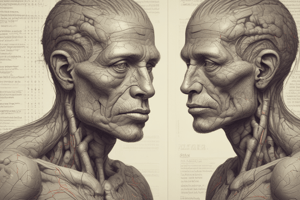Podcast
Questions and Answers
What hypothesis did early 20th-century scientists initially support regarding the determination of biological sex?
What hypothesis did early 20th-century scientists initially support regarding the determination of biological sex?
- Genetics does not influence sexual differentiation.
- Sex is determined solely by chromosomal makeup.
- External factors like temperature and nutrition play a role. (correct)
- Sex is determined through a random mutation process.
What specific discovery did Nettie Stevens make about chromosomes and sex determination?
What specific discovery did Nettie Stevens make about chromosomes and sex determination?
- Females have a mix of X and Y chromosomes.
- Sex differentiation occurs only at the embryonic stage.
- Males produce both X and Y chromosomes. (correct)
- Only males inherit two Y chromosomes.
At which academic institution did Nettie Stevens receive her doctorate?
At which academic institution did Nettie Stevens receive her doctorate?
- Bryn Mawr College (correct)
- Harvard University
- Stanford University
- Johns Hopkins University
What was the significance of Stevens's work with mealworms?
What was the significance of Stevens's work with mealworms?
How was Nettie Stevens's work perceived during her lifetime?
How was Nettie Stevens's work perceived during her lifetime?
What year did Nettie Stevens publish her findings on sex determination?
What year did Nettie Stevens publish her findings on sex determination?
Which prominent geneticist supervised Nettie Stevens during her doctorate studies?
Which prominent geneticist supervised Nettie Stevens during her doctorate studies?
What significant geological feature did the discovery in 1953 identify in the Atlantic?
What significant geological feature did the discovery in 1953 identify in the Atlantic?
What was one of George Washington Carver’s significant contributions to the agricultural industry?
What was one of George Washington Carver’s significant contributions to the agricultural industry?
What theory did the findings related to chaos behavior become foundational for?
What theory did the findings related to chaos behavior become foundational for?
What was Pavlov awarded the Nobel Prize in Physiology or Medicine for?
What was Pavlov awarded the Nobel Prize in Physiology or Medicine for?
What role did Thomas Hunt Morgan play in the field of genetics?
What role did Thomas Hunt Morgan play in the field of genetics?
What did J.J. Thomson identify that later came to be known as electrons?
What did J.J. Thomson identify that later came to be known as electrons?
In which year did George Washington Carver receive the Spingarn Medal?
In which year did George Washington Carver receive the Spingarn Medal?
What kind of farming methods did Carver teach at Tuskegee Institute?
What kind of farming methods did Carver teach at Tuskegee Institute?
Which scientist's work informed Einstein's theories, particularly regarding electromagnetism?
Which scientist's work informed Einstein's theories, particularly regarding electromagnetism?
Where did Thomas Hunt Morgan pursue his postgraduate studies?
Where did Thomas Hunt Morgan pursue his postgraduate studies?
At what age did Thomas Hunt Morgan gain his PhD in zoology?
At what age did Thomas Hunt Morgan gain his PhD in zoology?
What motivated Thomas Hunt Morgan's fascination with the natural world?
What motivated Thomas Hunt Morgan's fascination with the natural world?
What did Carver do in front of the US House of Representatives in 1921?
What did Carver do in front of the US House of Representatives in 1921?
What was one outcome of Carver’s teaching at Tuskegee Institute?
What was one outcome of Carver’s teaching at Tuskegee Institute?
What trait was specifically linked to the male line in the second generation of cross-bred flies?
What trait was specifically linked to the male line in the second generation of cross-bred flies?
What conclusion did Morgan reach about sex-linked traits through his experiments with fruit flies?
What conclusion did Morgan reach about sex-linked traits through his experiments with fruit flies?
Which sex chromosomes are present in female fruit flies?
Which sex chromosomes are present in female fruit flies?
What significant advancement in genetics did Morgan's work contribute to?
What significant advancement in genetics did Morgan's work contribute to?
What aspect of Mendel's work did Morgan recognize as valuable?
What aspect of Mendel's work did Morgan recognize as valuable?
Marie Curie's research primarily focused on which scientific field?
Marie Curie's research primarily focused on which scientific field?
How did Morgan's work differ from Mendel's, particularly in focus?
How did Morgan's work differ from Mendel's, particularly in focus?
Which of the following describes Morgan's contributions to the field of genetics?
Which of the following describes Morgan's contributions to the field of genetics?
What was a major finding related to male flies observed by Morgan?
What was a major finding related to male flies observed by Morgan?
What did Morgan's experiments with fruit flies ultimately lead to in genetics?
What did Morgan's experiments with fruit flies ultimately lead to in genetics?
What fundamental relationship does Einstein's equation E = mc² express?
What fundamental relationship does Einstein's equation E = mc² express?
What phenomenon does Einstein's theory of relativity predict concerning time in gravitational fields?
What phenomenon does Einstein's theory of relativity predict concerning time in gravitational fields?
How was Einstein's theory tested in 1919?
How was Einstein's theory tested in 1919?
What is the implication of the mass-energy equivalence for atomic nuclei?
What is the implication of the mass-energy equivalence for atomic nuclei?
What was one of the significant outcomes of Einstein's general theory of relativity during its introduction?
What was one of the significant outcomes of Einstein's general theory of relativity during its introduction?
In what way did Einstein extend the concepts of special relativity?
In what way did Einstein extend the concepts of special relativity?
What consequence arises from the large value of $c^2$ in the equation E = mc²?
What consequence arises from the large value of $c^2$ in the equation E = mc²?
Which aspect of light behavior was revolutionary according to Einstein's predictions?
Which aspect of light behavior was revolutionary according to Einstein's predictions?
What bend in light observed during a solar eclipse contradicted Newton's theory of gravity?
What bend in light observed during a solar eclipse contradicted Newton's theory of gravity?
What role does the concept of mass play in the context of nuclear power as described by Einstein?
What role does the concept of mass play in the context of nuclear power as described by Einstein?
Flashcards
Quantum Theory
Quantum Theory
A theory in physics that describes the energy of light as being quantized, meaning that energy can only exist in discrete units called quanta.
Sex Determination
Sex Determination
The process by which an organism's sex is determined, often by specific chromosomes.
Sex Chromosome
Sex Chromosome
A specific type of chromosome that determines the sex of an organism.
Nettie Stevens
Nettie Stevens
Signup and view all the flashcards
X and Y Chromosomes
X and Y Chromosomes
Signup and view all the flashcards
X Chromosome
X Chromosome
Signup and view all the flashcards
Genetics
Genetics
Signup and view all the flashcards
Carver's Role at Tuskegee Institute
Carver's Role at Tuskegee Institute
Signup and view all the flashcards
Carver's Contributions to Agriculture
Carver's Contributions to Agriculture
Signup and view all the flashcards
Carver's Advocacy for Peanut Farmers
Carver's Advocacy for Peanut Farmers
Signup and view all the flashcards
Carver's Quote on Education
Carver's Quote on Education
Signup and view all the flashcards
Thomas Hunt Morgan's Achievement
Thomas Hunt Morgan's Achievement
Signup and view all the flashcards
Morgan's Contribution to Genetics
Morgan's Contribution to Genetics
Signup and view all the flashcards
Morgan's Impact on Modern Genetics
Morgan's Impact on Modern Genetics
Signup and view all the flashcards
Morgan's Early Interest in Nature
Morgan's Early Interest in Nature
Signup and view all the flashcards
Morgan's Education and Research
Morgan's Education and Research
Signup and view all the flashcards
Sex-linked traits
Sex-linked traits
Signup and view all the flashcards
Genetic mapping
Genetic mapping
Signup and view all the flashcards
Chromosomal theory of inheritance
Chromosomal theory of inheritance
Signup and view all the flashcards
Gene linkage
Gene linkage
Signup and view all the flashcards
Sex-linked mutation
Sex-linked mutation
Signup and view all the flashcards
Confirmation of Mendel's work
Confirmation of Mendel's work
Signup and view all the flashcards
Marie Curie's contributions
Marie Curie's contributions
Signup and view all the flashcards
Radioactivity
Radioactivity
Signup and view all the flashcards
E=mc²
E=mc²
Signup and view all the flashcards
General Relativity
General Relativity
Signup and view all the flashcards
Gravitational Lensing
Gravitational Lensing
Signup and view all the flashcards
Special Relativity
Special Relativity
Signup and view all the flashcards
Time Dilation
Time Dilation
Signup and view all the flashcards
Mass-Energy Equivalence
Mass-Energy Equivalence
Signup and view all the flashcards
Starlight Deflection
Starlight Deflection
Signup and view all the flashcards
Nuclear Fission
Nuclear Fission
Signup and view all the flashcards
Spacetime Curvature
Spacetime Curvature
Signup and view all the flashcards
Principle of Relativity
Principle of Relativity
Signup and view all the flashcards
Study Notes
Scientists Who Changed History
- The book comprehensively covers significant scientists and their contributions to various fields.
- It focuses on scientists whose work profoundly impacted the world, particularly focusing on the period 1895-1925.
- This particular timeframe highlights several paradigm shifts in scientific understanding and methodology.
Santiago Ramón y Cajal
- Santiago Ramón y Cajal was a rebellious child with a passion for drawing
- His father was a doctor who encouraged him to pursue medicine, which eventually led him to neuroscience.
- He modified Golgi's staining technique to study the nervous system, specifically the microscopic anatomy in 1887.
- In 1888, he showed that nerve cells are not connected in a continuous web but are separate units.
- He published the first volume of his seminal book on the structure of the nervous system in 1899.
- He and Golgi jointly won the Nobel Prize in 1906 for their research on the structure of the nervous system.
- Cajal's artwork was extremely detailed in illustrations of the human brain and nervous system
Max Planck
- Planck's work on heat and radiation led to the concept of quanta or packets of energy.
- It refuted the ideas of continuous energy emission in classical physics.
- He presented his quantum theory of light as discrete energy packets to the German Physical Society in 1900.
- His research on radiation led to his receiving the Nobel Prize in Physics in 1919.
- This work profoundly altered the paradigm of the subatomic world, paving the way for modern physics.
Nettie Stevens
- Nettie Stevens, a US biologist, made a major discovery about sex determination and chromosomes.
- She found that sex is determined by particular chromosomes (X and Y) in 1905.
- She showed a link between a physical characteristic and a specific chromosome, connecting physics and biology.
- Stevens's work provided a vital breakthrough in early genetics.
- Her contributions were not widely recognized until after her death in 1912
George Washington Carver
- George Washington Carver was an African American agricultural scientist known for his groundbreaking techniques for soil improvement and crop cultivation.
- He developed commercially viable products from crops like peanuts (287 products from peanuts, and 118 from sweet potatoes).
- Carver was a significant figure in agricultural science in the South, helping the local economy recover post-Civil War.
- Instrumental in educating farmers about crop diversification.
Thomas Hunt Morgan
- Thomas Hunt Morgan discovered the role of chromosomes in heredity in 1904.
- His research used fruit flies because of their rapid reproduction, showing patterns of inheritance.
- He confirmed that traits are inherited linked to chromosomes, similar to Mendel's work on plants.
- Morgan's meticulous experimental work established a foundation for modern genetics.
Marie Curie
- Marie Curie (née Skłodowska) was a Polish and naturalized-French physicist and chemist.
- Her pioneering research on radioactivity was groundbreaking, discovering two new radioactive elements -polonium (named after her native Poland) and radium, in 1898.
- Her work revolutionized chemistry and led to applications including radiotherapy.
- She notably won two Nobel Prizes: the 1903 Nobel Prize in Physics and the 1911 Nobel Prize in Chemistry for her pioneering work with radioactivity.
Ernest Rutherford
- Through experiments and observation, Ernest Rutherford concluded that atoms have a positively charged nucleus at the center, with electrons surrounding it.
- Discovered alpha and beta radiations from uranium and other radioactive elements, establishing different types of radiation.
- His findings revolutionized our comprehension of atomic structure, leading to groundbreaking developments.
António Egas Moniz
- A Portuguese neurologist, António Egas Moniz devised the controversial surgical procedure frontal lobotomy for treating psychiatric illnesses.
- His early 1930s invention revolutionized psychiatric treatment (however these procedures proved ineffective and had serious side effects).
- Invented angiograms – an X-ray diagnostic method for blood vessels.
Lise Meitner
- Lise Meitner was a brilliant theoretical nuclear physicist.
- She and her nephew Otto Frisch coined the term "nuclear fission" in 1938.
- The discovery was crucial in explaining the splitting of uranium atoms.
- Meitner's work, despite important collaboration, was not widely recognized for decades.
Albert Einstein
- Albert Einstein was a German-born theoretical physicist.
- Known for his work on relativity: general and special theories of relativity- dramatically changing how we understand space, time, and gravity.
- His work paved the way for numerous scientific advancements, including nuclear energy and solar power.
Alfred Wegener
- A German meteorologist and polar explorer, Alfred Wegener proposed the theory of continental drift.
- Wegener's work detailed fossil and geological evidence that suggested continents had once been joined.
- Wegener's ideas were revolutionary but faced skepticism at the time of publication.
Jane Goodall
- Jane Goodall was a British primatologist known for her extensive research on chimpanzees.
- Her fifty-five years of study in Gombe National Park led to important insights into chimpanzee behavior.
- Goodall's observations broadened society’s awareness of the intelligence and social complexity of chimpanzees.
Valentina Tereshkova
- A Soviet cosmonaut, Valentina Tereshkova is the first woman to travel in space.
- Her first solo space mission was in 1963.
Patricia Bath
- American ophthalmologist Patricia Bath developed the Laserphaco Probe to treat cataracts and other eye conditions.
- Her critical contributions in improved surgical procedures and techniques for eye conditions significantly improved patient outcomes.
Stephen Hawking
- Stephen Hawking was a famous British theoretical physicist.
- His work on black holes, space-time, and the expanding universe revolutionized our understanding of the cosmos.
- Suffering from ALS, he revolutionized our insight into cosmology and the laws of physics (and also helped make physics into a popular field).
James Till
- James Till was a Canadian physicist whose collaboration with Ernest McCulloch on radiation treatment led to vital breakthroughs in stem-cell research.
- His and McCulloch's shared research on stem cell research led to a better understanding of their role in creating and renewing vital blood components. This work provided critical advancements in the treatment of various leukemias.
Tu Youyou
- Tu Youyou was a Chinese pharmacologist.
- She discovered artemisinin in 1971, a crucial new antimalaria treatment, for which she received the Nobel Prize in Physiology or Medicine in 2015.
- Tu’s breakthrough was based on traditional Chinese medicine and her meticulous research.
Tim Berners-Lee
- Tim Berners-Lee invented the World Wide Web.
- He created the foundational standards (HTML, HTTP) that allow for online communication and access to data.
- His creation has had profound societal and economic impacts world-wide.
Henry Stommel
- Henry Stommel studied oceanography, specifically focusing on ocean currents.
- His pioneering work on the Gulf Stream and ocean circulation profoundly impacted marine science.
- He refined the understanding of thermohaline circulation patterns, helping us comprehend larger ocean systems globally.
Yang Chen-Ning
- Yang Chen-Ning was a renowned Chinese physicist who made groundbreaking discoveries in particle physics.
- He worked extensively on the transformation of subatomic particles using conservation of parity and symmetry - paving the way for modern physics.
- His contributions in subatomic physics, jointly with Tsung Dao Lee, earned them the 1957 Nobel Prize in Physics.
Benoît Mandelbrot
- Benoît Mandelbrot was a Polish-born French mathematician.
- He developed the mathematical concepts of fractal geometry, a field crucial for understanding complex phenomena and patterns in nature.
- His methods are used widely today in image processing, weather patterns, and finance.
Richard Feynman
- Richard Feynman was a brilliant American theoretical physicist.
- Feynman is known for his revolutionary work in physics, particularly in quantum electrodynamics (QED), including the well-known Feynman diagrams.
- He made profound contributions to several areas of physics and made seemingly complex concepts easier to understand.
Other Notables
- The book includes other significant scientists in various fields; these individuals were crucial in their domains, and details of their work are included to reflect their contributions.
Studying That Suits You
Use AI to generate personalized quizzes and flashcards to suit your learning preferences.




